Consumer Behavior Dynamics in the International Tourism Sector
VerifiedAdded on 2023/01/17
|10
|2446
|79
Report
AI Summary
This report analyzes consumer behavior within the international travel and tourism sector, focusing on the dynamics that influence tourist decisions. It begins by outlining the consumer decision-making journey, mapping the path to purchase for tourism services, and emphasizing the importance of understanding this process for marketers. The report then contrasts the B2B and B2C approaches to tourism decision-making, providing specific examples. It explores various market research methods used to understand consumer behavior and evaluates how marketers can effectively influence each stage of the decision-making process. The report uses examples from TUI Group and other tourism businesses to illustrate key concepts, providing a comprehensive overview of consumer behavior within the industry. This report provides a complete overview of consumer behaviour within the industry.
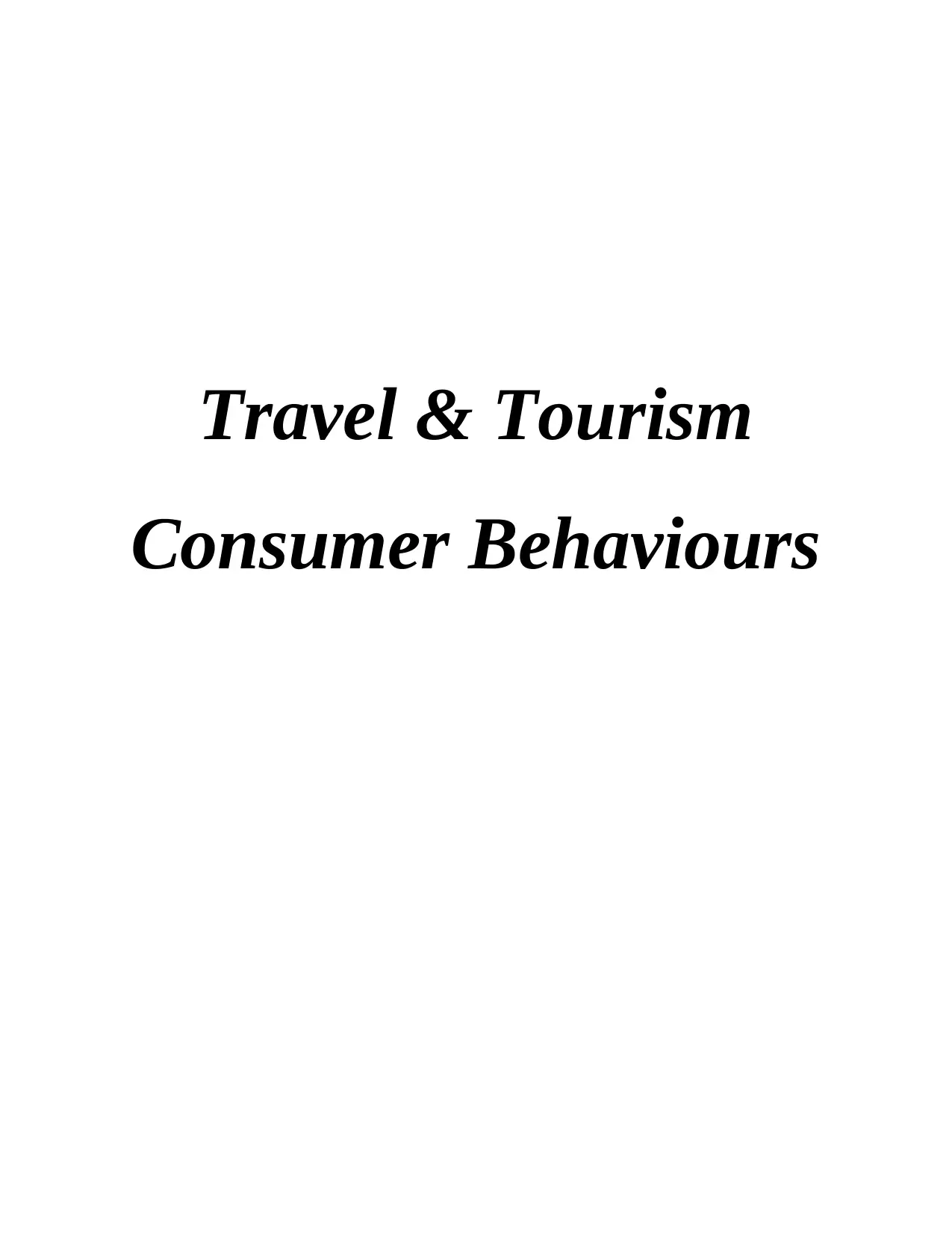
Travel & Tourism
Consumer Behaviours
Consumer Behaviours
Paraphrase This Document
Need a fresh take? Get an instant paraphrase of this document with our AI Paraphraser
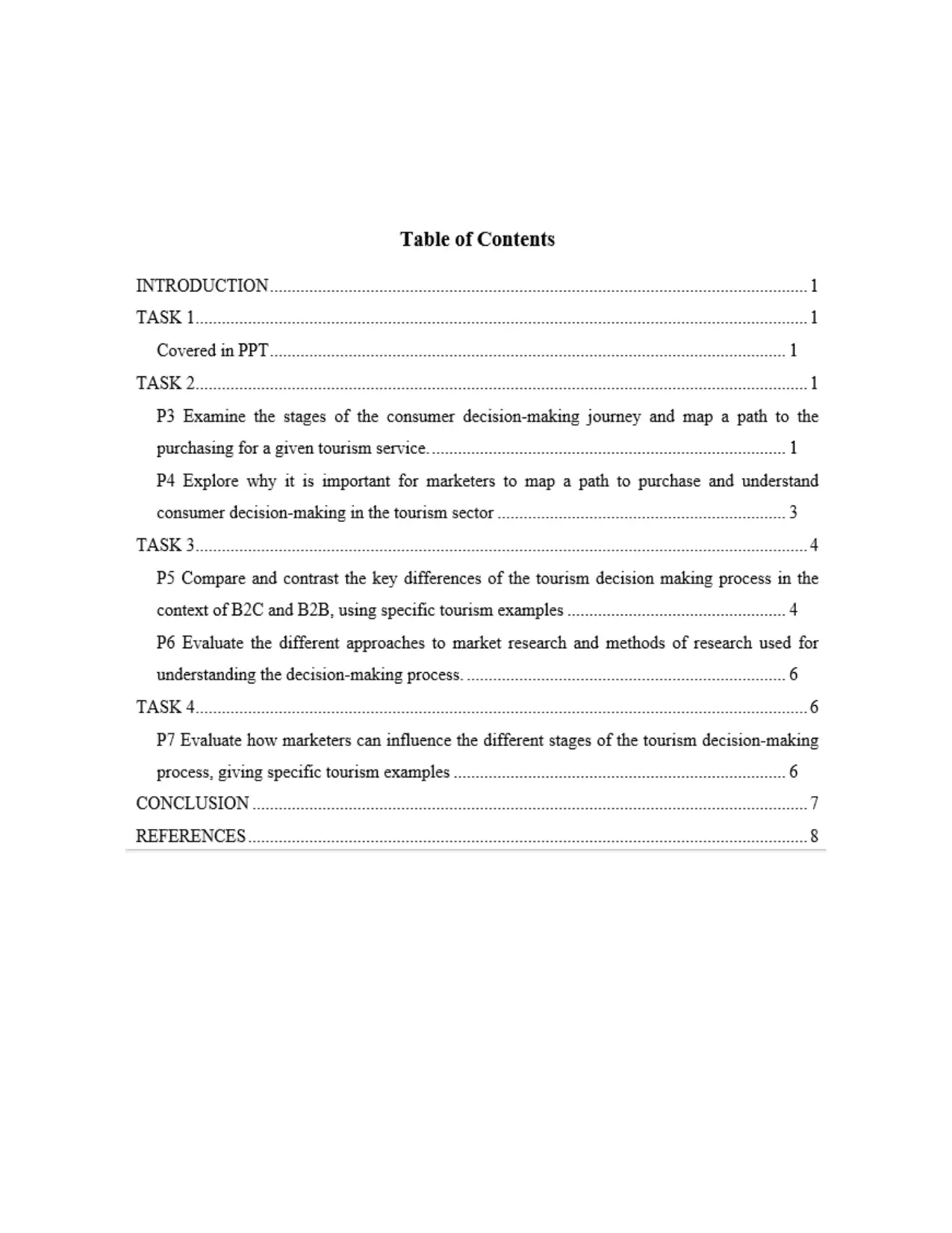
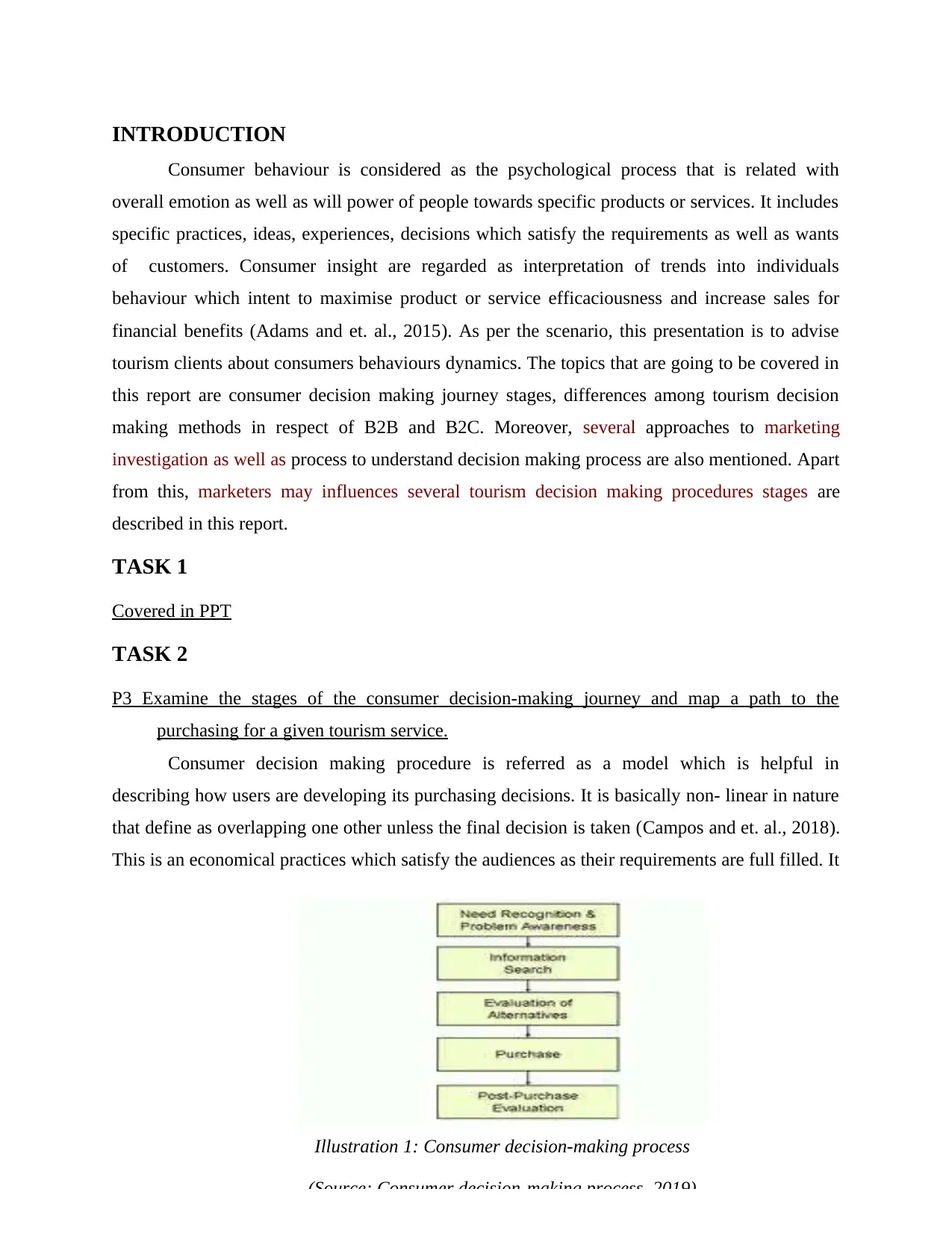
INTRODUCTION
Consumer behaviour is considered as the psychological process that is related with
overall emotion as well as will power of people towards specific products or services. It includes
specific practices, ideas, experiences, decisions which satisfy the requirements as well as wants
of customers. Consumer insight are regarded as interpretation of trends into individuals
behaviour which intent to maximise product or service efficaciousness and increase sales for
financial benefits (Adams and et. al., 2015). As per the scenario, this presentation is to advise
tourism clients about consumers behaviours dynamics. The topics that are going to be covered in
this report are consumer decision making journey stages, differences among tourism decision
making methods in respect of B2B and B2C. Moreover, several approaches to marketing
investigation as well as process to understand decision making process are also mentioned. Apart
from this, marketers may influences several tourism decision making procedures stages are
described in this report.
TASK 1
Covered in PPT
TASK 2
P3 Examine the stages of the consumer decision-making journey and map a path to the
purchasing for a given tourism service.
Consumer decision making procedure is referred as a model which is helpful in
describing how users are developing its purchasing decisions. It is basically non- linear in nature
that define as overlapping one other unless the final decision is taken (Campos and et. al., 2018).
This is an economical practices which satisfy the audiences as their requirements are full filled. It
1Illustration 1: Consumer decision-making process
(Source: Consumer decision-making process. 2019)
Consumer behaviour is considered as the psychological process that is related with
overall emotion as well as will power of people towards specific products or services. It includes
specific practices, ideas, experiences, decisions which satisfy the requirements as well as wants
of customers. Consumer insight are regarded as interpretation of trends into individuals
behaviour which intent to maximise product or service efficaciousness and increase sales for
financial benefits (Adams and et. al., 2015). As per the scenario, this presentation is to advise
tourism clients about consumers behaviours dynamics. The topics that are going to be covered in
this report are consumer decision making journey stages, differences among tourism decision
making methods in respect of B2B and B2C. Moreover, several approaches to marketing
investigation as well as process to understand decision making process are also mentioned. Apart
from this, marketers may influences several tourism decision making procedures stages are
described in this report.
TASK 1
Covered in PPT
TASK 2
P3 Examine the stages of the consumer decision-making journey and map a path to the
purchasing for a given tourism service.
Consumer decision making procedure is referred as a model which is helpful in
describing how users are developing its purchasing decisions. It is basically non- linear in nature
that define as overlapping one other unless the final decision is taken (Campos and et. al., 2018).
This is an economical practices which satisfy the audiences as their requirements are full filled. It
1Illustration 1: Consumer decision-making process
(Source: Consumer decision-making process. 2019)
⊘ This is a preview!⊘
Do you want full access?
Subscribe today to unlock all pages.

Trusted by 1+ million students worldwide
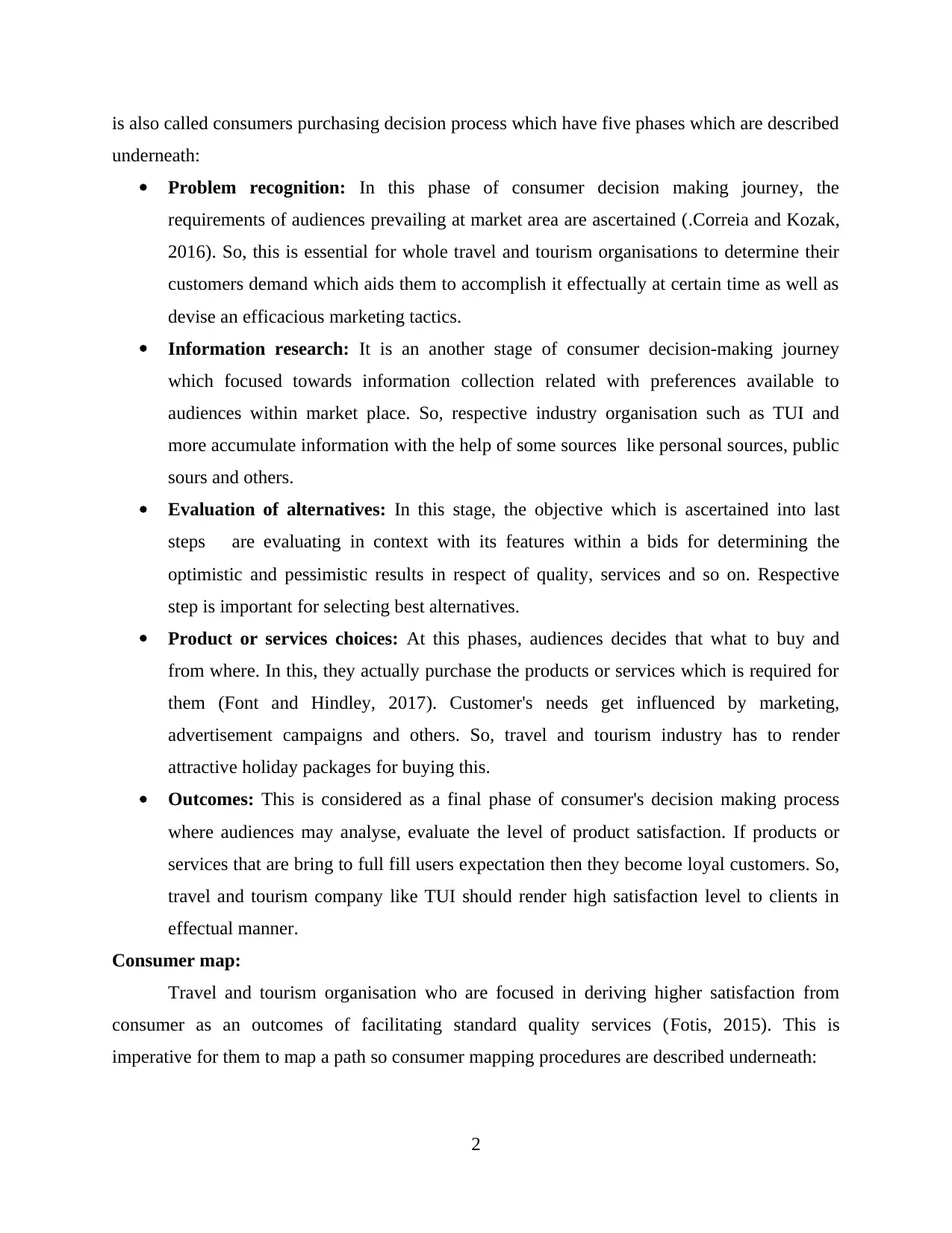
is also called consumers purchasing decision process which have five phases which are described
underneath:
Problem recognition: In this phase of consumer decision making journey, the
requirements of audiences prevailing at market area are ascertained (.Correia and Kozak,
2016). So, this is essential for whole travel and tourism organisations to determine their
customers demand which aids them to accomplish it effectually at certain time as well as
devise an efficacious marketing tactics.
Information research: It is an another stage of consumer decision-making journey
which focused towards information collection related with preferences available to
audiences within market place. So, respective industry organisation such as TUI and
more accumulate information with the help of some sources like personal sources, public
sours and others.
Evaluation of alternatives: In this stage, the objective which is ascertained into last
steps are evaluating in context with its features within a bids for determining the
optimistic and pessimistic results in respect of quality, services and so on. Respective
step is important for selecting best alternatives.
Product or services choices: At this phases, audiences decides that what to buy and
from where. In this, they actually purchase the products or services which is required for
them (Font and Hindley, 2017). Customer's needs get influenced by marketing,
advertisement campaigns and others. So, travel and tourism industry has to render
attractive holiday packages for buying this.
Outcomes: This is considered as a final phase of consumer's decision making process
where audiences may analyse, evaluate the level of product satisfaction. If products or
services that are bring to full fill users expectation then they become loyal customers. So,
travel and tourism company like TUI should render high satisfaction level to clients in
effectual manner.
Consumer map:
Travel and tourism organisation who are focused in deriving higher satisfaction from
consumer as an outcomes of facilitating standard quality services (Fotis, 2015). This is
imperative for them to map a path so consumer mapping procedures are described underneath:
2
underneath:
Problem recognition: In this phase of consumer decision making journey, the
requirements of audiences prevailing at market area are ascertained (.Correia and Kozak,
2016). So, this is essential for whole travel and tourism organisations to determine their
customers demand which aids them to accomplish it effectually at certain time as well as
devise an efficacious marketing tactics.
Information research: It is an another stage of consumer decision-making journey
which focused towards information collection related with preferences available to
audiences within market place. So, respective industry organisation such as TUI and
more accumulate information with the help of some sources like personal sources, public
sours and others.
Evaluation of alternatives: In this stage, the objective which is ascertained into last
steps are evaluating in context with its features within a bids for determining the
optimistic and pessimistic results in respect of quality, services and so on. Respective
step is important for selecting best alternatives.
Product or services choices: At this phases, audiences decides that what to buy and
from where. In this, they actually purchase the products or services which is required for
them (Font and Hindley, 2017). Customer's needs get influenced by marketing,
advertisement campaigns and others. So, travel and tourism industry has to render
attractive holiday packages for buying this.
Outcomes: This is considered as a final phase of consumer's decision making process
where audiences may analyse, evaluate the level of product satisfaction. If products or
services that are bring to full fill users expectation then they become loyal customers. So,
travel and tourism company like TUI should render high satisfaction level to clients in
effectual manner.
Consumer map:
Travel and tourism organisation who are focused in deriving higher satisfaction from
consumer as an outcomes of facilitating standard quality services (Fotis, 2015). This is
imperative for them to map a path so consumer mapping procedures are described underneath:
2
Paraphrase This Document
Need a fresh take? Get an instant paraphrase of this document with our AI Paraphraser
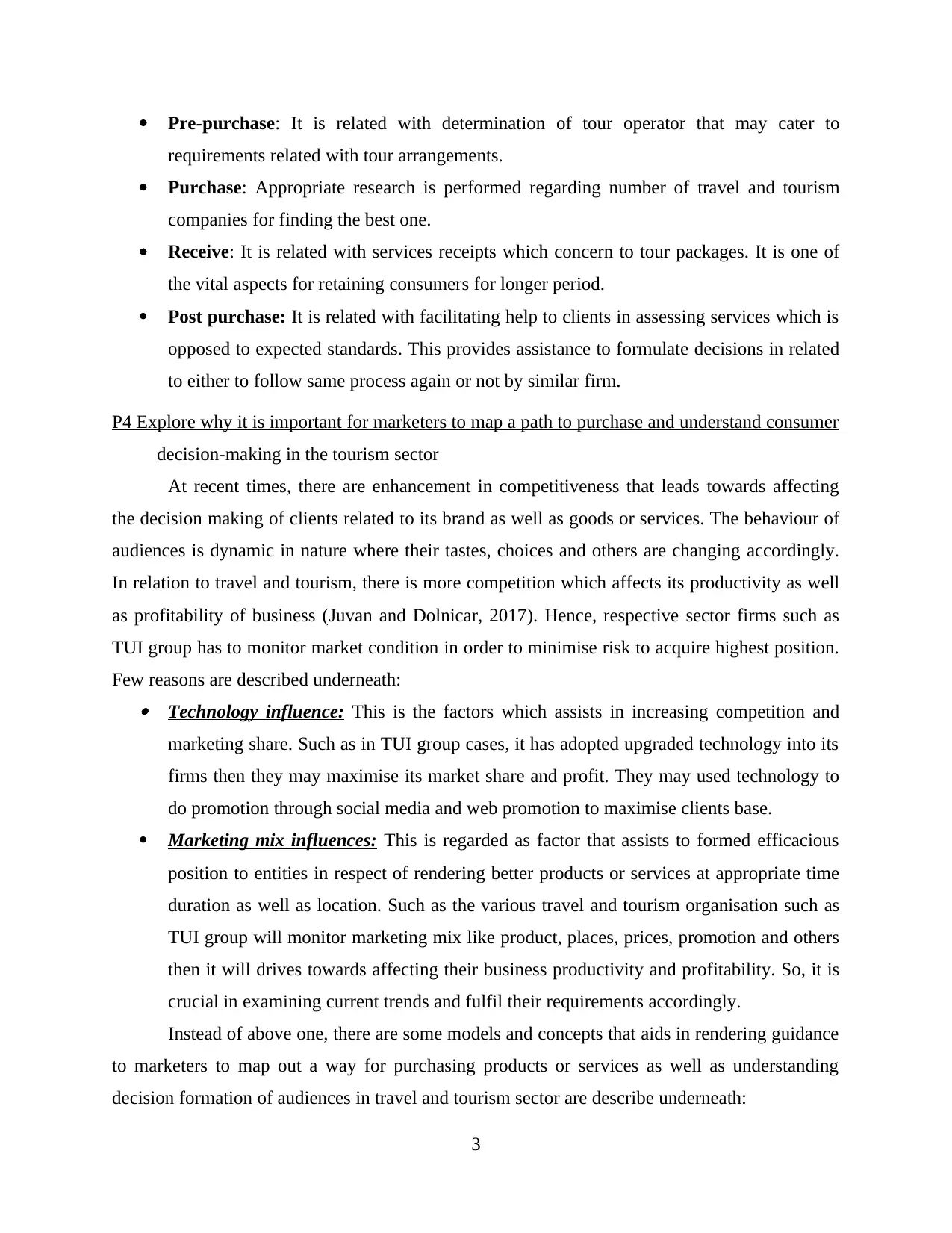
Pre-purchase: It is related with determination of tour operator that may cater to
requirements related with tour arrangements.
Purchase: Appropriate research is performed regarding number of travel and tourism
companies for finding the best one.
Receive: It is related with services receipts which concern to tour packages. It is one of
the vital aspects for retaining consumers for longer period.
Post purchase: It is related with facilitating help to clients in assessing services which is
opposed to expected standards. This provides assistance to formulate decisions in related
to either to follow same process again or not by similar firm.
P4 Explore why it is important for marketers to map a path to purchase and understand consumer
decision-making in the tourism sector
At recent times, there are enhancement in competitiveness that leads towards affecting
the decision making of clients related to its brand as well as goods or services. The behaviour of
audiences is dynamic in nature where their tastes, choices and others are changing accordingly.
In relation to travel and tourism, there is more competition which affects its productivity as well
as profitability of business (Juvan and Dolnicar, 2017). Hence, respective sector firms such as
TUI group has to monitor market condition in order to minimise risk to acquire highest position.
Few reasons are described underneath: Technology influence: This is the factors which assists in increasing competition and
marketing share. Such as in TUI group cases, it has adopted upgraded technology into its
firms then they may maximise its market share and profit. They may used technology to
do promotion through social media and web promotion to maximise clients base.
Marketing mix influences: This is regarded as factor that assists to formed efficacious
position to entities in respect of rendering better products or services at appropriate time
duration as well as location. Such as the various travel and tourism organisation such as
TUI group will monitor marketing mix like product, places, prices, promotion and others
then it will drives towards affecting their business productivity and profitability. So, it is
crucial in examining current trends and fulfil their requirements accordingly.
Instead of above one, there are some models and concepts that aids in rendering guidance
to marketers to map out a way for purchasing products or services as well as understanding
decision formation of audiences in travel and tourism sector are describe underneath:
3
requirements related with tour arrangements.
Purchase: Appropriate research is performed regarding number of travel and tourism
companies for finding the best one.
Receive: It is related with services receipts which concern to tour packages. It is one of
the vital aspects for retaining consumers for longer period.
Post purchase: It is related with facilitating help to clients in assessing services which is
opposed to expected standards. This provides assistance to formulate decisions in related
to either to follow same process again or not by similar firm.
P4 Explore why it is important for marketers to map a path to purchase and understand consumer
decision-making in the tourism sector
At recent times, there are enhancement in competitiveness that leads towards affecting
the decision making of clients related to its brand as well as goods or services. The behaviour of
audiences is dynamic in nature where their tastes, choices and others are changing accordingly.
In relation to travel and tourism, there is more competition which affects its productivity as well
as profitability of business (Juvan and Dolnicar, 2017). Hence, respective sector firms such as
TUI group has to monitor market condition in order to minimise risk to acquire highest position.
Few reasons are described underneath: Technology influence: This is the factors which assists in increasing competition and
marketing share. Such as in TUI group cases, it has adopted upgraded technology into its
firms then they may maximise its market share and profit. They may used technology to
do promotion through social media and web promotion to maximise clients base.
Marketing mix influences: This is regarded as factor that assists to formed efficacious
position to entities in respect of rendering better products or services at appropriate time
duration as well as location. Such as the various travel and tourism organisation such as
TUI group will monitor marketing mix like product, places, prices, promotion and others
then it will drives towards affecting their business productivity and profitability. So, it is
crucial in examining current trends and fulfil their requirements accordingly.
Instead of above one, there are some models and concepts that aids in rendering guidance
to marketers to map out a way for purchasing products or services as well as understanding
decision formation of audiences in travel and tourism sector are describe underneath:
3
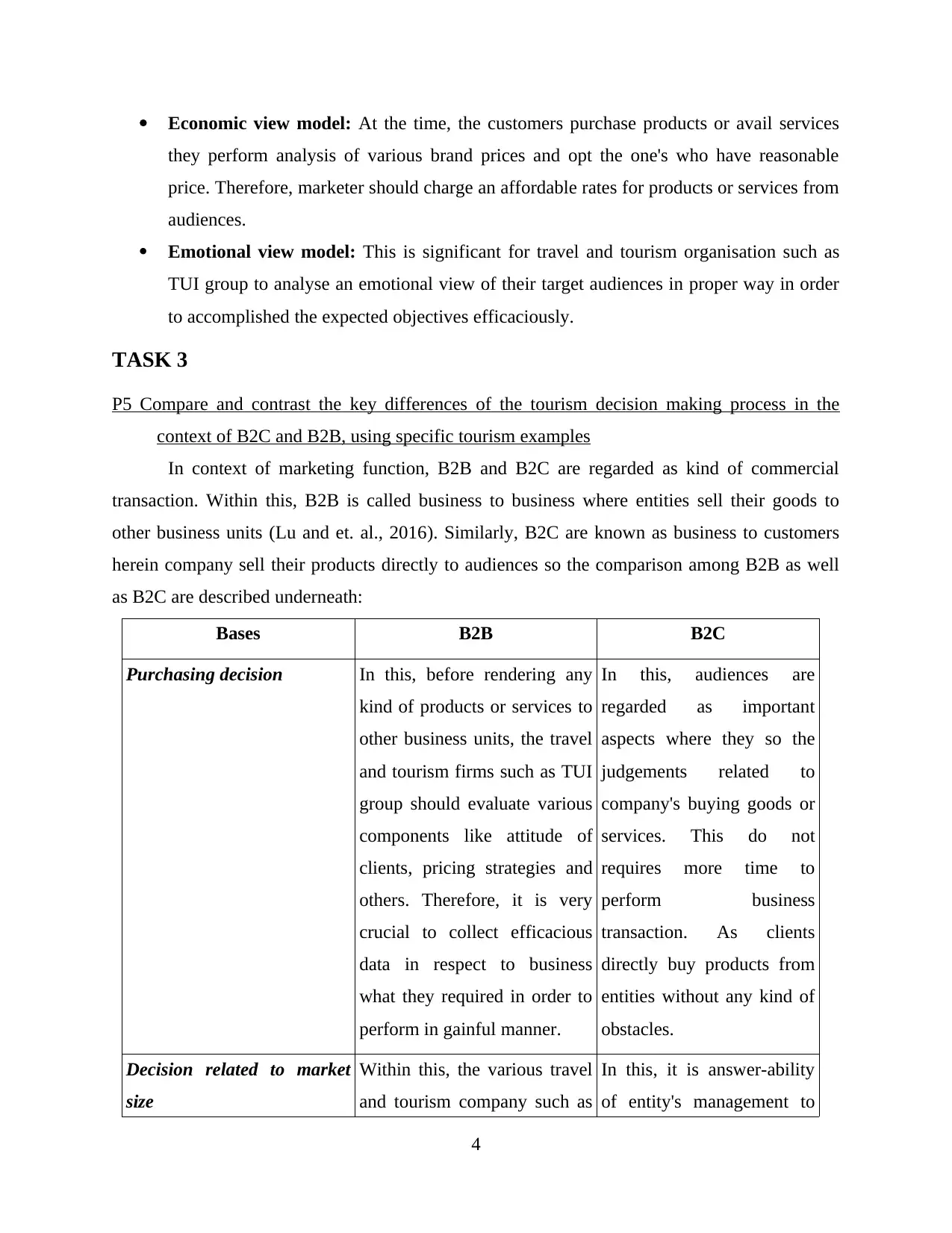
Economic view model: At the time, the customers purchase products or avail services
they perform analysis of various brand prices and opt the one's who have reasonable
price. Therefore, marketer should charge an affordable rates for products or services from
audiences.
Emotional view model: This is significant for travel and tourism organisation such as
TUI group to analyse an emotional view of their target audiences in proper way in order
to accomplished the expected objectives efficaciously.
TASK 3
P5 Compare and contrast the key differences of the tourism decision making process in the
context of B2C and B2B, using specific tourism examples
In context of marketing function, B2B and B2C are regarded as kind of commercial
transaction. Within this, B2B is called business to business where entities sell their goods to
other business units (Lu and et. al., 2016). Similarly, B2C are known as business to customers
herein company sell their products directly to audiences so the comparison among B2B as well
as B2C are described underneath:
Bases B2B B2C
Purchasing decision In this, before rendering any
kind of products or services to
other business units, the travel
and tourism firms such as TUI
group should evaluate various
components like attitude of
clients, pricing strategies and
others. Therefore, it is very
crucial to collect efficacious
data in respect to business
what they required in order to
perform in gainful manner.
In this, audiences are
regarded as important
aspects where they so the
judgements related to
company's buying goods or
services. This do not
requires more time to
perform business
transaction. As clients
directly buy products from
entities without any kind of
obstacles.
Decision related to market
size
Within this, the various travel
and tourism company such as
In this, it is answer-ability
of entity's management to
4
they perform analysis of various brand prices and opt the one's who have reasonable
price. Therefore, marketer should charge an affordable rates for products or services from
audiences.
Emotional view model: This is significant for travel and tourism organisation such as
TUI group to analyse an emotional view of their target audiences in proper way in order
to accomplished the expected objectives efficaciously.
TASK 3
P5 Compare and contrast the key differences of the tourism decision making process in the
context of B2C and B2B, using specific tourism examples
In context of marketing function, B2B and B2C are regarded as kind of commercial
transaction. Within this, B2B is called business to business where entities sell their goods to
other business units (Lu and et. al., 2016). Similarly, B2C are known as business to customers
herein company sell their products directly to audiences so the comparison among B2B as well
as B2C are described underneath:
Bases B2B B2C
Purchasing decision In this, before rendering any
kind of products or services to
other business units, the travel
and tourism firms such as TUI
group should evaluate various
components like attitude of
clients, pricing strategies and
others. Therefore, it is very
crucial to collect efficacious
data in respect to business
what they required in order to
perform in gainful manner.
In this, audiences are
regarded as important
aspects where they so the
judgements related to
company's buying goods or
services. This do not
requires more time to
perform business
transaction. As clients
directly buy products from
entities without any kind of
obstacles.
Decision related to market
size
Within this, the various travel
and tourism company such as
In this, it is answer-ability
of entity's management to
4
⊘ This is a preview!⊘
Do you want full access?
Subscribe today to unlock all pages.

Trusted by 1+ million students worldwide
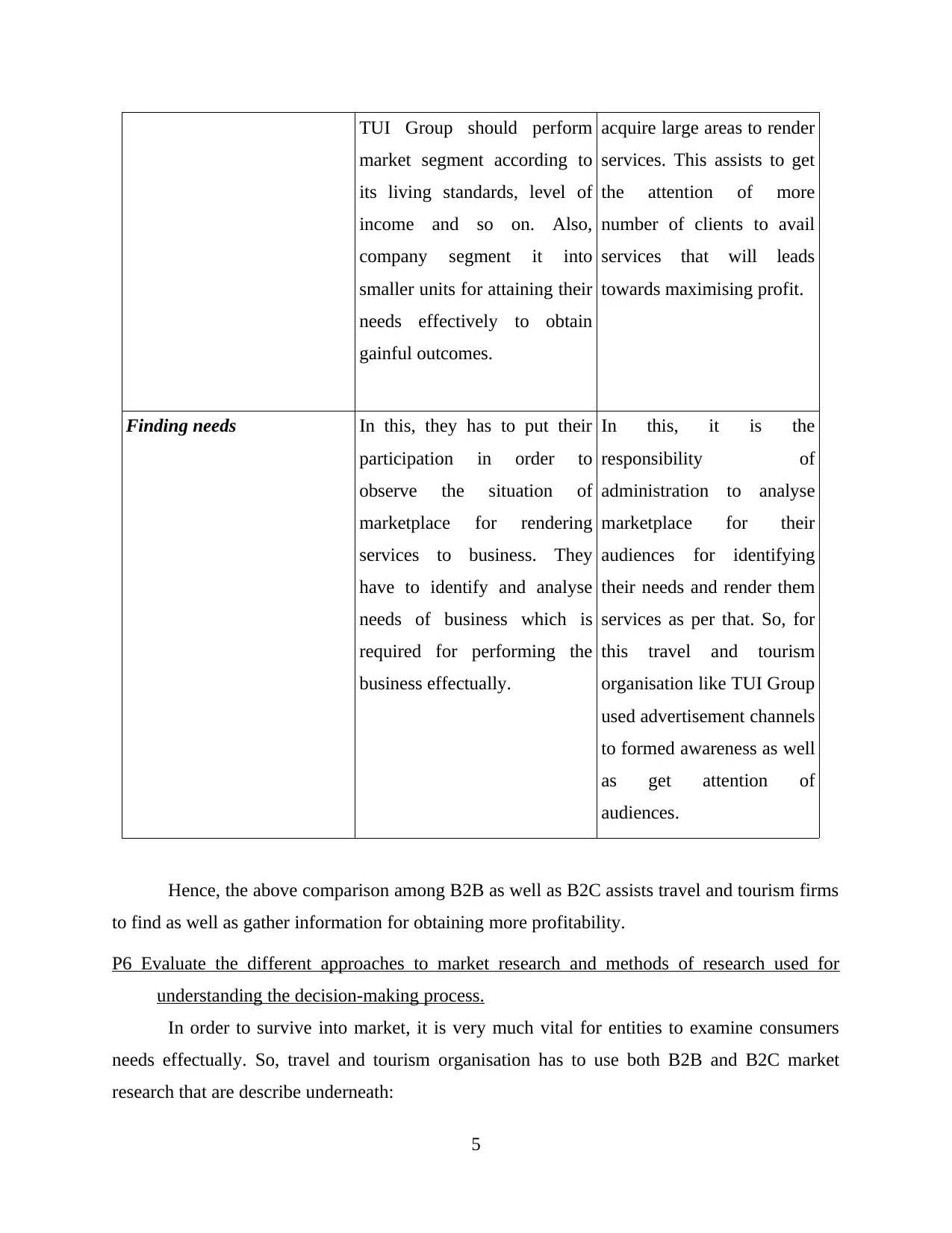
TUI Group should perform
market segment according to
its living standards, level of
income and so on. Also,
company segment it into
smaller units for attaining their
needs effectively to obtain
gainful outcomes.
acquire large areas to render
services. This assists to get
the attention of more
number of clients to avail
services that will leads
towards maximising profit.
Finding needs In this, they has to put their
participation in order to
observe the situation of
marketplace for rendering
services to business. They
have to identify and analyse
needs of business which is
required for performing the
business effectually.
In this, it is the
responsibility of
administration to analyse
marketplace for their
audiences for identifying
their needs and render them
services as per that. So, for
this travel and tourism
organisation like TUI Group
used advertisement channels
to formed awareness as well
as get attention of
audiences.
Hence, the above comparison among B2B as well as B2C assists travel and tourism firms
to find as well as gather information for obtaining more profitability.
P6 Evaluate the different approaches to market research and methods of research used for
understanding the decision-making process.
In order to survive into market, it is very much vital for entities to examine consumers
needs effectually. So, travel and tourism organisation has to use both B2B and B2C market
research that are describe underneath:
5
market segment according to
its living standards, level of
income and so on. Also,
company segment it into
smaller units for attaining their
needs effectively to obtain
gainful outcomes.
acquire large areas to render
services. This assists to get
the attention of more
number of clients to avail
services that will leads
towards maximising profit.
Finding needs In this, they has to put their
participation in order to
observe the situation of
marketplace for rendering
services to business. They
have to identify and analyse
needs of business which is
required for performing the
business effectually.
In this, it is the
responsibility of
administration to analyse
marketplace for their
audiences for identifying
their needs and render them
services as per that. So, for
this travel and tourism
organisation like TUI Group
used advertisement channels
to formed awareness as well
as get attention of
audiences.
Hence, the above comparison among B2B as well as B2C assists travel and tourism firms
to find as well as gather information for obtaining more profitability.
P6 Evaluate the different approaches to market research and methods of research used for
understanding the decision-making process.
In order to survive into market, it is very much vital for entities to examine consumers
needs effectually. So, travel and tourism organisation has to use both B2B and B2C market
research that are describe underneath:
5
Paraphrase This Document
Need a fresh take? Get an instant paraphrase of this document with our AI Paraphraser
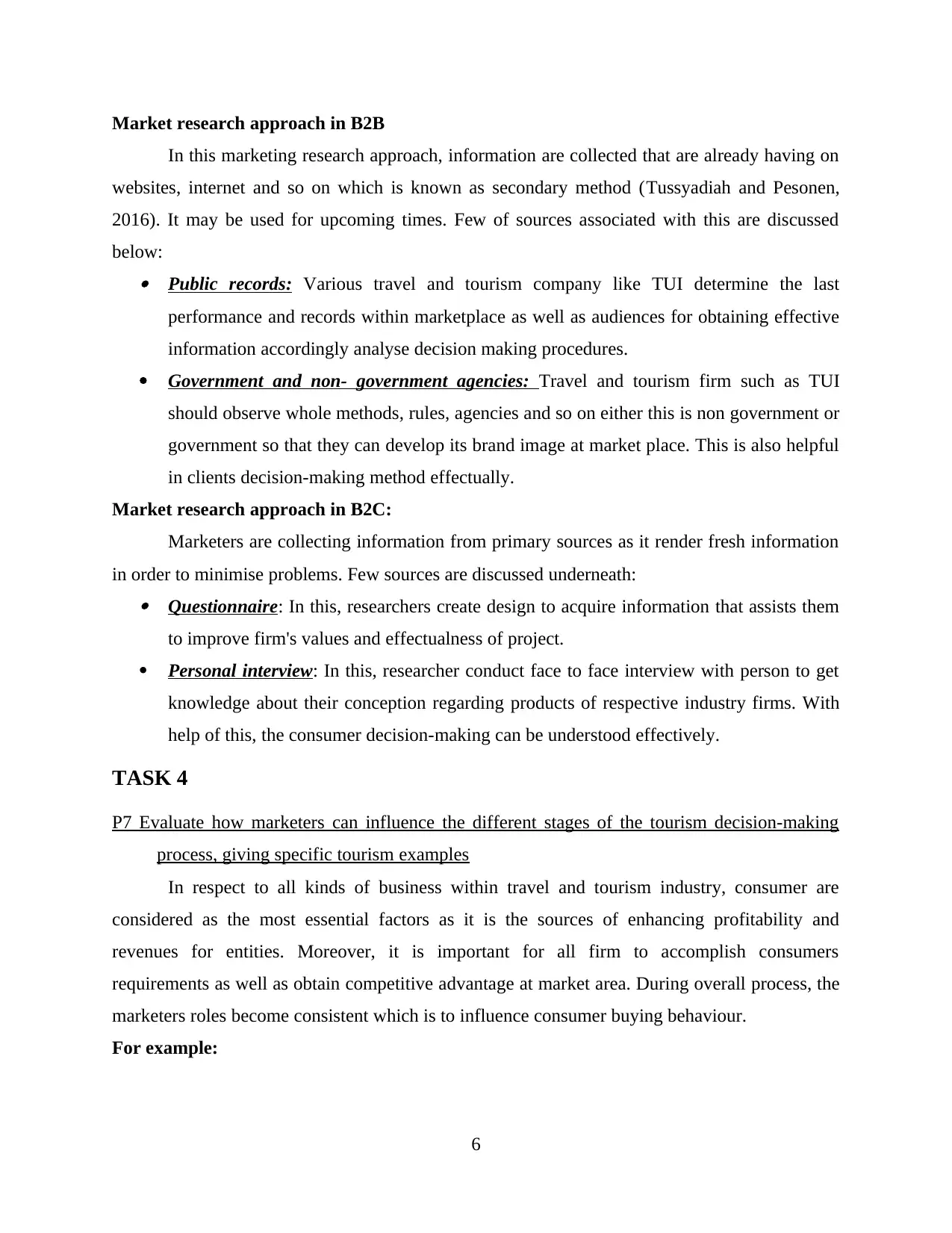
Market research approach in B2B
In this marketing research approach, information are collected that are already having on
websites, internet and so on which is known as secondary method (Tussyadiah and Pesonen,
2016). It may be used for upcoming times. Few of sources associated with this are discussed
below: Public records: Various travel and tourism company like TUI determine the last
performance and records within marketplace as well as audiences for obtaining effective
information accordingly analyse decision making procedures.
Government and non- government agencies: Travel and tourism firm such as TUI
should observe whole methods, rules, agencies and so on either this is non government or
government so that they can develop its brand image at market place. This is also helpful
in clients decision-making method effectually.
Market research approach in B2C:
Marketers are collecting information from primary sources as it render fresh information
in order to minimise problems. Few sources are discussed underneath: Questionnaire: In this, researchers create design to acquire information that assists them
to improve firm's values and effectualness of project.
Personal interview: In this, researcher conduct face to face interview with person to get
knowledge about their conception regarding products of respective industry firms. With
help of this, the consumer decision-making can be understood effectively.
TASK 4
P7 Evaluate how marketers can influence the different stages of the tourism decision-making
process, giving specific tourism examples
In respect to all kinds of business within travel and tourism industry, consumer are
considered as the most essential factors as it is the sources of enhancing profitability and
revenues for entities. Moreover, it is important for all firm to accomplish consumers
requirements as well as obtain competitive advantage at market area. During overall process, the
marketers roles become consistent which is to influence consumer buying behaviour.
For example:
6
In this marketing research approach, information are collected that are already having on
websites, internet and so on which is known as secondary method (Tussyadiah and Pesonen,
2016). It may be used for upcoming times. Few of sources associated with this are discussed
below: Public records: Various travel and tourism company like TUI determine the last
performance and records within marketplace as well as audiences for obtaining effective
information accordingly analyse decision making procedures.
Government and non- government agencies: Travel and tourism firm such as TUI
should observe whole methods, rules, agencies and so on either this is non government or
government so that they can develop its brand image at market place. This is also helpful
in clients decision-making method effectually.
Market research approach in B2C:
Marketers are collecting information from primary sources as it render fresh information
in order to minimise problems. Few sources are discussed underneath: Questionnaire: In this, researchers create design to acquire information that assists them
to improve firm's values and effectualness of project.
Personal interview: In this, researcher conduct face to face interview with person to get
knowledge about their conception regarding products of respective industry firms. With
help of this, the consumer decision-making can be understood effectively.
TASK 4
P7 Evaluate how marketers can influence the different stages of the tourism decision-making
process, giving specific tourism examples
In respect to all kinds of business within travel and tourism industry, consumer are
considered as the most essential factors as it is the sources of enhancing profitability and
revenues for entities. Moreover, it is important for all firm to accomplish consumers
requirements as well as obtain competitive advantage at market area. During overall process, the
marketers roles become consistent which is to influence consumer buying behaviour.
For example:
6
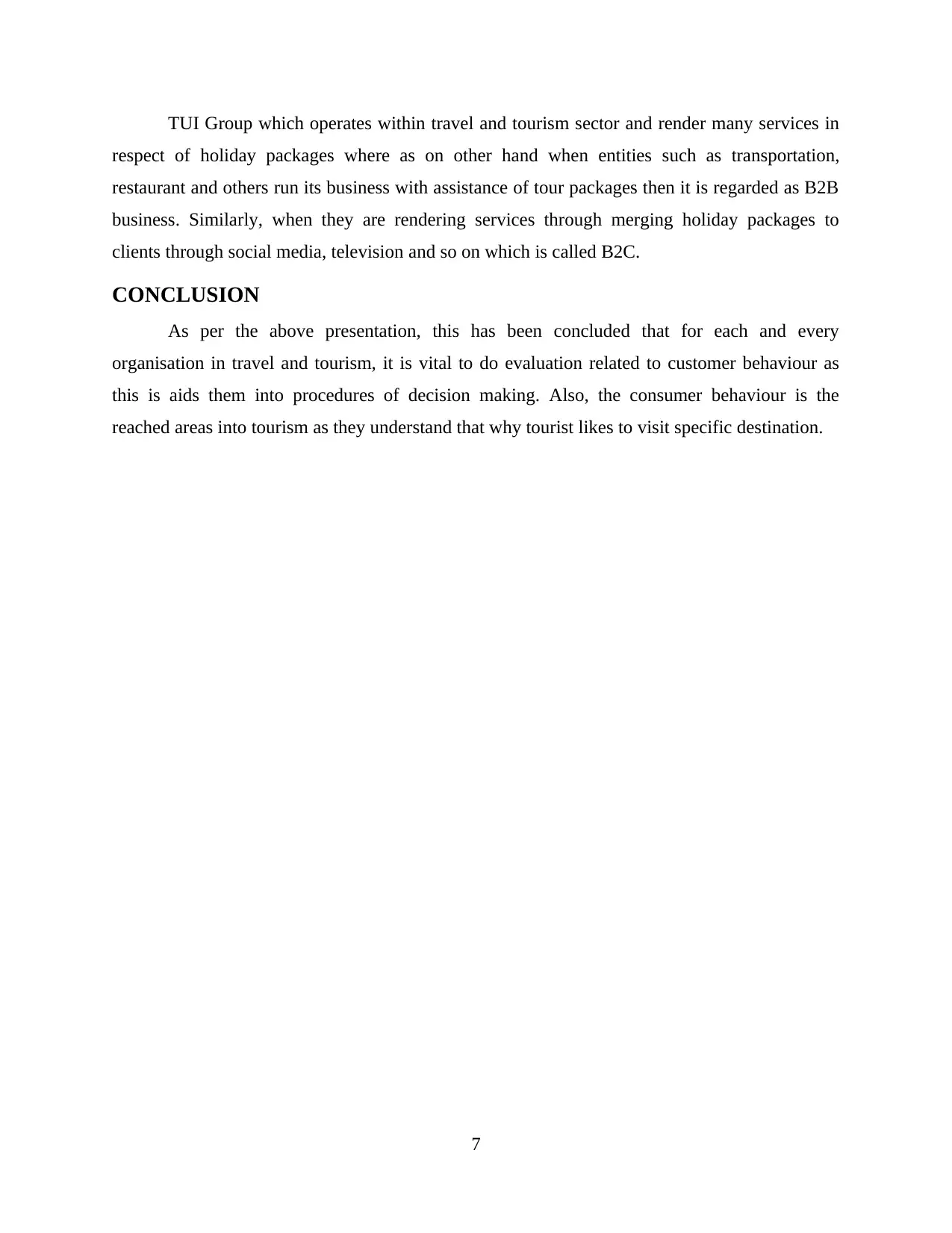
TUI Group which operates within travel and tourism sector and render many services in
respect of holiday packages where as on other hand when entities such as transportation,
restaurant and others run its business with assistance of tour packages then it is regarded as B2B
business. Similarly, when they are rendering services through merging holiday packages to
clients through social media, television and so on which is called B2C.
CONCLUSION
As per the above presentation, this has been concluded that for each and every
organisation in travel and tourism, it is vital to do evaluation related to customer behaviour as
this is aids them into procedures of decision making. Also, the consumer behaviour is the
reached areas into tourism as they understand that why tourist likes to visit specific destination.
7
respect of holiday packages where as on other hand when entities such as transportation,
restaurant and others run its business with assistance of tour packages then it is regarded as B2B
business. Similarly, when they are rendering services through merging holiday packages to
clients through social media, television and so on which is called B2C.
CONCLUSION
As per the above presentation, this has been concluded that for each and every
organisation in travel and tourism, it is vital to do evaluation related to customer behaviour as
this is aids them into procedures of decision making. Also, the consumer behaviour is the
reached areas into tourism as they understand that why tourist likes to visit specific destination.
7
⊘ This is a preview!⊘
Do you want full access?
Subscribe today to unlock all pages.

Trusted by 1+ million students worldwide
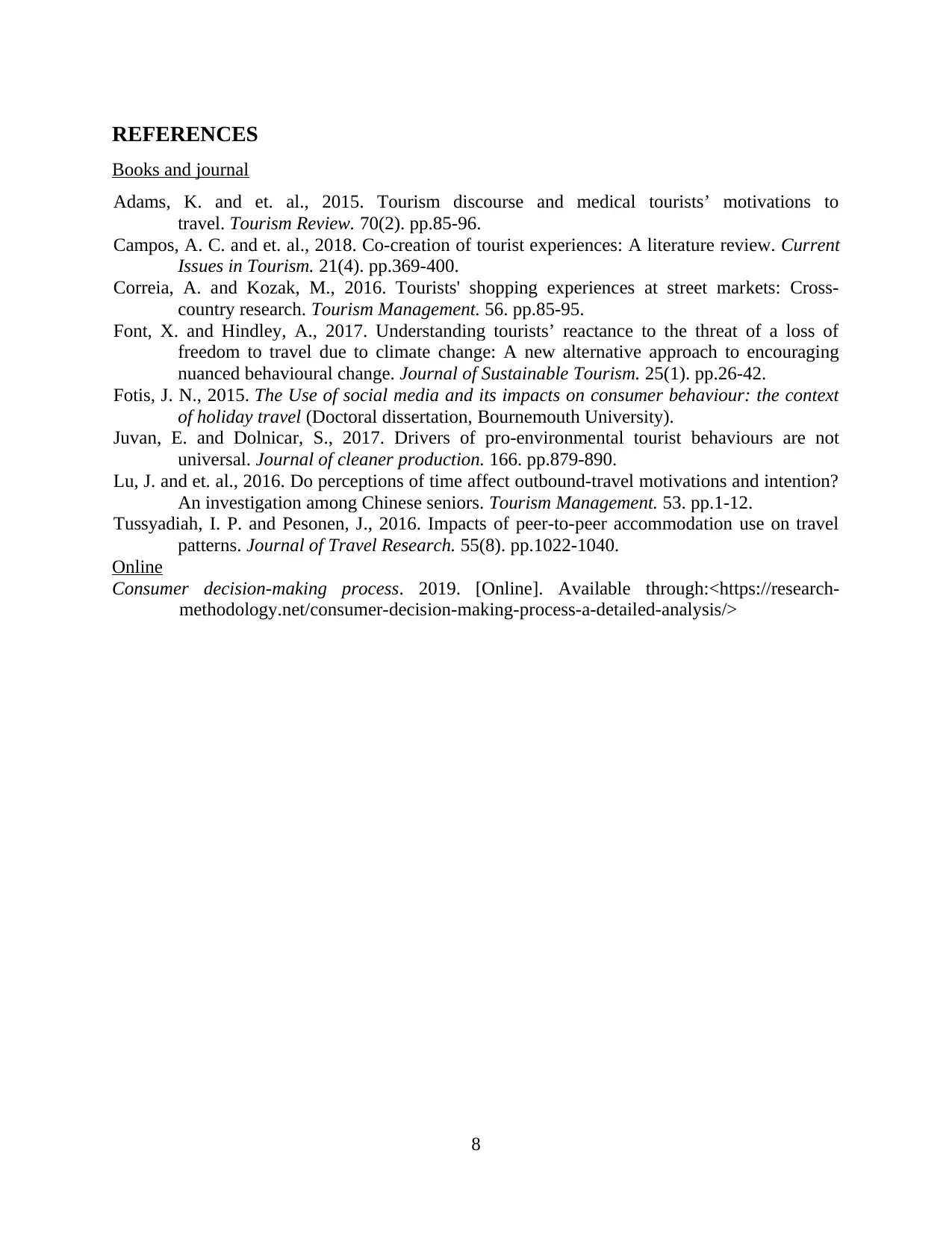
REFERENCES
Books and journal
Adams, K. and et. al., 2015. Tourism discourse and medical tourists’ motivations to
travel. Tourism Review. 70(2). pp.85-96.
Campos, A. C. and et. al., 2018. Co-creation of tourist experiences: A literature review. Current
Issues in Tourism. 21(4). pp.369-400.
Correia, A. and Kozak, M., 2016. Tourists' shopping experiences at street markets: Cross-
country research. Tourism Management. 56. pp.85-95.
Font, X. and Hindley, A., 2017. Understanding tourists’ reactance to the threat of a loss of
freedom to travel due to climate change: A new alternative approach to encouraging
nuanced behavioural change. Journal of Sustainable Tourism. 25(1). pp.26-42.
Fotis, J. N., 2015. The Use of social media and its impacts on consumer behaviour: the context
of holiday travel (Doctoral dissertation, Bournemouth University).
Juvan, E. and Dolnicar, S., 2017. Drivers of pro-environmental tourist behaviours are not
universal. Journal of cleaner production. 166. pp.879-890.
Lu, J. and et. al., 2016. Do perceptions of time affect outbound-travel motivations and intention?
An investigation among Chinese seniors. Tourism Management. 53. pp.1-12.
Tussyadiah, I. P. and Pesonen, J., 2016. Impacts of peer-to-peer accommodation use on travel
patterns. Journal of Travel Research. 55(8). pp.1022-1040.
Online
Consumer decision-making process. 2019. [Online]. Available through:<https://research-
methodology.net/consumer-decision-making-process-a-detailed-analysis/>
8
Books and journal
Adams, K. and et. al., 2015. Tourism discourse and medical tourists’ motivations to
travel. Tourism Review. 70(2). pp.85-96.
Campos, A. C. and et. al., 2018. Co-creation of tourist experiences: A literature review. Current
Issues in Tourism. 21(4). pp.369-400.
Correia, A. and Kozak, M., 2016. Tourists' shopping experiences at street markets: Cross-
country research. Tourism Management. 56. pp.85-95.
Font, X. and Hindley, A., 2017. Understanding tourists’ reactance to the threat of a loss of
freedom to travel due to climate change: A new alternative approach to encouraging
nuanced behavioural change. Journal of Sustainable Tourism. 25(1). pp.26-42.
Fotis, J. N., 2015. The Use of social media and its impacts on consumer behaviour: the context
of holiday travel (Doctoral dissertation, Bournemouth University).
Juvan, E. and Dolnicar, S., 2017. Drivers of pro-environmental tourist behaviours are not
universal. Journal of cleaner production. 166. pp.879-890.
Lu, J. and et. al., 2016. Do perceptions of time affect outbound-travel motivations and intention?
An investigation among Chinese seniors. Tourism Management. 53. pp.1-12.
Tussyadiah, I. P. and Pesonen, J., 2016. Impacts of peer-to-peer accommodation use on travel
patterns. Journal of Travel Research. 55(8). pp.1022-1040.
Online
Consumer decision-making process. 2019. [Online]. Available through:<https://research-
methodology.net/consumer-decision-making-process-a-detailed-analysis/>
8
1 out of 10
Related Documents
Your All-in-One AI-Powered Toolkit for Academic Success.
+13062052269
info@desklib.com
Available 24*7 on WhatsApp / Email
![[object Object]](/_next/static/media/star-bottom.7253800d.svg)
Unlock your academic potential
Copyright © 2020–2025 A2Z Services. All Rights Reserved. Developed and managed by ZUCOL.





